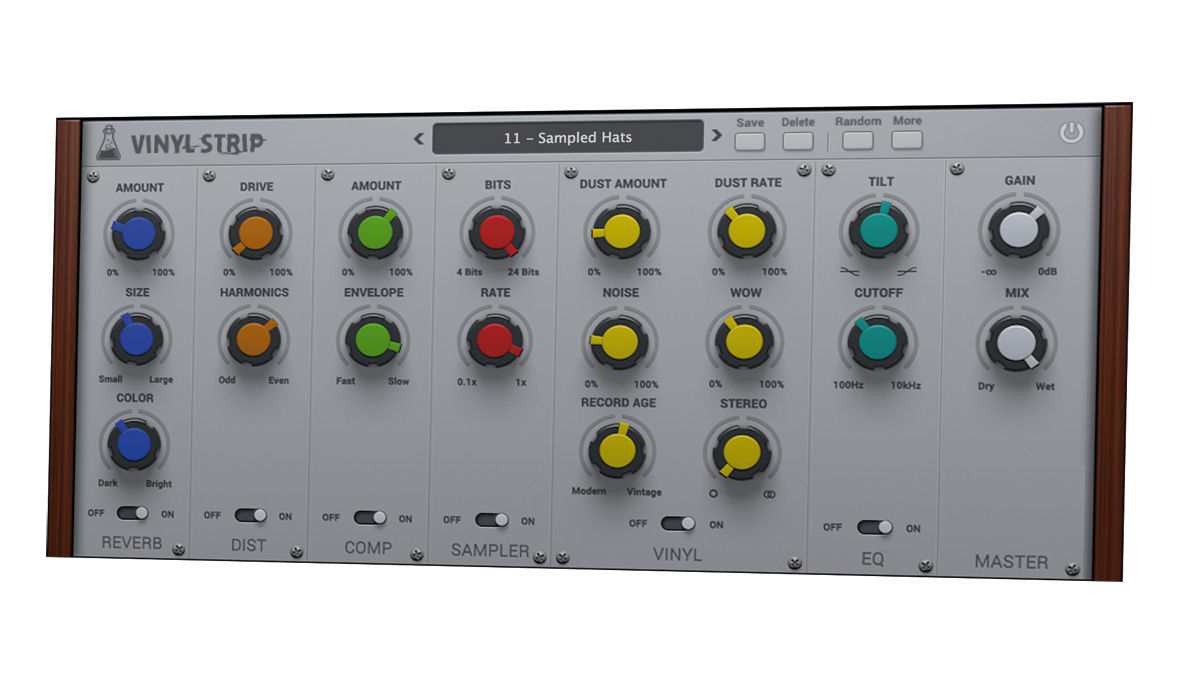MusicRadar Verdict
Much more than just a vinyl emulator, Vinyl Strip is one of the most interesting, versatile 'vintagiser' plugins we've used.
Pros
- +
Convincing vinyl emulation. Easy to use. Fantastic sound. Customisable and versatile. Great mix tools.
Cons
- -
No L/R mono signal selector.
MusicRadar's got your back
Aiming to slake our seemingly unquenchable thirst for hot wax, Vinyl Strip is a multieffects plugin (VST2/AU/AAX) aimed at delivering a range of classic vinyl sounds and flavours in one handy processor.
Its six modules - Compression, Distortion, Reverb, EQ, Vinyl and Sampler - can be manually reordered and activated independently, and each emulates a particular aspect of vinyl recording and playback.
Compression has just two controls - Amount and Envelope (fast/slow action) - and is great for creating that cut-to-vinyl sound. Much of the 'sound' of vinyl masters is down to the compression and EQ used by cutting engineers to squeeze the signal onto that famously temperamental medium.
Significant gain is also required to compensate for heavy compression, so the Compression algorithm includes automatic gain make-up.
Distortion also features two controls: Drive and Harmonics. Drive raises the gain into the distortion circuit, while Harmonics transitions from all Odd to all Even harmonics, passing from Odd's quite punchy transistor-sounding edge, to heavy valve-style, top-end-attenuating distortion at the Even end. It's a great module with countless mixing applications.
Reverb might seem like a strange inclusion, but its relevance becomes clear when you use it. Early recordings employed far fewer microphones and channels than studios have access to today, so there's an inherent sense of natural space to almost everything recorded before the mid-60s.
Three controls - Amount, Size and Color - add a sense of space to individual channels and groups, with the Color control being highly effective at rolling off tell- tale bright modern tails.
EQ is designed to mimic the way old tracks were heard rather than how they were recorded. A so-called 'tilt EQ', it's modelled on the tone controls found on old hi-fis and consists of two linked shelving filters.
Dialled anticlockwise, it attenuates the top end and boosts the lows; turned clockwise, it adds top and attenuates the lows. The centre frequency for both filters is set using the shared Cutoff control.
The Vinyl module is the most complex of the six, offering a wide range of controls to emulate the sound of a record being played back. It can be used to recreate everything from boxy 7-inch 50s hipster-porn to blunt-hugging, bass-heavy 90s hip-hop 12-inchers.
A little bit more
Speaking of hip-hop, the final module, Sampler, very convincingly emulates the sounds of early samplers (thus covering almost all early hip-hop, house and breakbeat genres until the mid-90s) via its Bits and Rate controls.
Finally, the Main section offers Gain and Dry/ Wet controls, the latter being particularly useful when using the individual modules as mix tools. There's also a Randomizer function and a small selection of presets to get you started, but really, it's all very intuitive, so getting the sound you're after is never difficult.
Vinyl Strip is a cracking plugin, ideal for treating individual channels and processing whole loops/groups. It does exactly what it sets out to, with the added bonus of offering five versatile mixing tools, so even if you're not looking to bring the sound of classic wax to your productions, it's highly recommended.
Computer Music magazine is the world’s best selling publication dedicated solely to making great music with your Mac or PC computer. Each issue it brings its lucky readers the best in cutting-edge tutorials, need-to-know, expert software reviews and even all the tools you actually need to make great music today, courtesy of our legendary CM Plugin Suite.
"There’s plenty for us guitarists to learn – and ‘less is more’ is the overriding lesson": how to play like George Harrison on The Beatles' Abbey Road
“They didn’t like Prince’s bikini underwear”: Prince’s support sets for the The Rolling Stones in 1981 are remembered as disastrous, but guitarist Dez Dickerson says that the the crowd reaction wasn’t as bad as people think
“We are so unencumbered and unbothered by these externally imposed rules or other people’s ideas for what music should be”: Blood Incantation on the making of Absolute Elsewhere and how “Data from Star Trek” saved the album – and the studio











